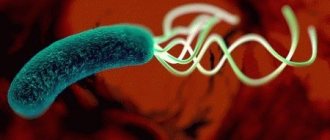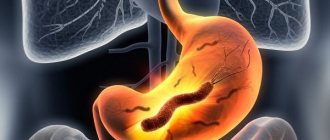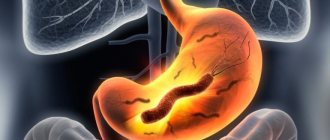Diagnostics
The choice of diagnostic methods and treatment program for Helicobacter pylori infection is carried out, taking into account mainly the existing manifestations of pathology in the infected person. When dyspeptic symptoms are detected, a gastroenterologist prescribes a series of tests and instrumental examinations to confirm the fact of the disease and conduct a differential diagnosis.
When should you look for Helicobacter pylori?
There are a number of indications for which it is recommended to be examined for the presence of Helicobacter pylori infection. It is recommended to undergo a diagnostic test for the following symptoms:
- the presence of dyspeptic symptoms (pain or discomfort in the upper abdomen, nausea, flatulence, abnormal stool, etc.);
- daily bad breath;
- chronic inflammation of the stomach;
- chronic inflammation of the duodenum;
- peptic ulcer of the stomach and/or duodenum;
- malignant formation of the stomach (adenocarcinoma or MALT lymphoma);
- recurrent caries;
- gastroesophageal reflux;
- taking proton pump blockers (omeprazole, pantoprozole, lansoprozole, etc.) for more than 10 days;
- detection of Helicobacter pylori infection in family members;
- burdened hereditary history (cases of gastric or duodenal ulcer, stomach cancer in close relatives);
- deterioration in the appearance of the skin (acne and allergic reactions);
- control of cure after anti-Helicobacter therapy.
Diagnosis before treatment
After a general examination and palpation of the abdominal area, the gastroenterologist may recommend a number of tests and additional examinations:
- complete blood count (detects a decrease in the level of red blood cells and hemoglobin in case of anemia);
- general urine analysis;
- coprogram (reveals signs of digestive disorders);
- stool examination for occult blood (to determine possible bleeding);
- blood test for (decreased levels of pepsinogen I and II, increased gastrin observed in autoimmune gastritis);
- fibrogastroduodenoscopy with collection of biopsy samples from 5 zones of the stomach for subsequent histological examination of the gastric mucosa;
- measurement of the acidity of gastric contents using methods of intragastric pH-metry and sounding;
- studies to detect Helicobacter pylori;
- fluoroscopic examination;
- Ultrasound of the abdominal organs.
The standard for diagnosing Helicobacter pylori gastritis is an endoscopic examination with further histological examination of the biopsy material, which makes it possible to determine the degree of contamination of the gastric mucosa with Helicobacter pylori bacteria, the severity of inflammation, atrophic and metaplastic changes.
There are the following methods for detecting Helicobacter pylori:
- Invasive methods (study of pieces of mucous membrane obtained during biopsy during fibrogastroduodenoscopy):
- bacteriological examination (inoculation on a special medium);
- histochemical examination (staining of histological preparations with subsequent evaluation of the results under a microscope);
- PCR diagnostics;
- rapid urease test.
- Non-invasive methods:
- serological method (determining the level of antibodies to Helicobacter pylori in the patient’s blood);
- PCR (detection of pathogen antigen in the patient’s stool);
- breath test (consists of recording labeled carbon in exhaled carbon dioxide, which is formed during the splitting of an ingested urea solution with a labeled carbon atom by the bacterial enzyme urease).
Diagnosis after treatment
The main criteria for assessing therapy for Helicobacter pylori gastritis are the condition of the gastric mucosa and eradication (complete destruction) of Helicobacter pylori. The morphological state of the mucosa can be assessed during repeated fibrogastroduodenoscopy (for erosive and ulcerative lesions). To obtain reliable results on the eradication of Helicobacter pylori, you must adhere to the following rules:
- Diagnosis of eradication is carried out no earlier than 1 month after anti-Helicobacter therapy or the use of any antibiotics and antisecretory agents.
- To monitor cure, it is advisable to use two of the methods listed above.
- To monitor eradication, a breath test or detection of Helicobacter pylori antigen in stool is recommended.
Prevention
If a person does not have gastritis and does not want to get sick, he will need, first of all, to lead a healthy lifestyle, eat right and remain careful while taking any medications. If symptoms of gastritis appear, it is recommended to consult a doctor as soon as possible in order to correctly diagnose the disease and prescribe appropriate treatment.
To prevent Helicobacter pylori infection, you can drink 1 teaspoon of rosehip syrup daily. The effective remedy is used for a month. After a month of taking the syrup, take a break for two weeks. And if there is a need to resume taking it for preventive purposes, the course is repeated.
It is imperative to observe the rules of personal hygiene. Before eating - wash your hands, after using the toilet - wash your hands, never use dirty dishes and towels. Do not use other people's personal hygiene items. If a family member has been diagnosed with Helicobacter pylori infection, the rest of the family members also need to undergo a medical examination to detect Helicobacter pylori.
Source
Treatment
Gastritis caused by Helibacter pylori is treated with antibacterial drugs. Typically, four- or three-component treatment regimens are used. They include several different antibacterial drugs. This therapeutic regimen usually gives good results.
But in recent years, problems have arisen with treatment using this regimen. This is due to the increasing resistance of Helibacter pylori strains to antibiotics. Doctors tried to solve this problem by changing medications and increasing the duration of treatment.
Today, triple therapy regimens include the following drugs: proton pump inhibitors, amoxicillin and clarithromycin. When repeating a course, a four-component treatment regimen can be used. The minimum duration of treatment is usually a week.
It is worth noting that such treatment regimens can destroy Helibacter pylori in 90% of patients. In any case, the attending physician will choose one or another treatment regimen after conducting a thorough diagnosis.
Treatment with traditional methods
Folk remedies will not replace the main treatment, but will be an effective addition to medications and diet. To combat Helicobacter pylori, herbs that have an antibacterial effect should be used.
To treat Helicobacter pylori gastritis, you can use the following tinctures:
- Propolis. 60 g of beekeeping product should be boiled for 1 hour in 200 ml of water. Drink 1 tsp. Store the tincture in the refrigerator for no more than 10 days.
- St. John's wort. To prepare the tincture you will need 6 tbsp. l. dry herbs and 250 ml of vodka. Drink 1 tsp after 20 days. After dinner.
- Golden mustache. Chop a large leaf, pour 700 ml of boiling water and cook for 15 minutes. Take no more than 10 days.
- Elecampane root. You will need 30 g of raw materials and 0.75 liters of vodka. Use the tincture after 2 weeks, when the root has infused. Drink before meals, 25-30 drops dissolved in water.
Plantain has a powerful antibacterial effect. To get rid of the excruciating pain of gastritis, you need to eat one leaf a day.
In addition to tinctures that have an antibacterial effect, the following folk remedies are also effective:
- Oat jelly. It turns out mucous, envelops the walls of the stomach and relieves pain.
- Potato or cabbage juice. Before each meal, you need to drink a third of a glass of fresh juice.
- Carrot juice. It even relieves chronic gastritis. You need to drink 100 ml on an empty stomach for 3 weeks.
- Aloe juice. You need to drink it 2 tsp. before eating. The course of therapy is a month.
- Chamomile decoction. This remedy has an anti-inflammatory effect. For cooking you need 1 tbsp. l. pour 400 ml of boiling water over the flowers.
- Peppermint decoction. An excellent sedative that should be brewed like tea.
Preferably 30 minutes in the morning. Before meals, drink 200 ml of clean boiled water, and also eat up to 200 g of honey (can be dissolved in water).
Before treatment with folk remedies, it is advisable to consult a gastroenterologist.
How does bacteria work?
In the stomach, Helicobacter pylori finds favorable conditions for existence. There is always, although not in large quantities, urea available from the blood. It is this bacterium that is used to attack the organ mucosa.
Action diagram:
- Using a special enzyme, the bacterium produces ammonia;
- The latter neutralizes hydrochloric acid and prepares the conditions for further attack;
- With the help of another enzyme, it destroys protein and thins mucus;
- Helicobakter pylori skillfully attaches to the epithelial cells of the organ mucosa;
- Epithelial cells rapidly die, and the bacterium actively occupies a significant part of the mucosa.
This is how the inflammatory process starts and develops.
The bacterium continues to produce cytotoxins, leading to further damage to the gastric mucosa.
If the cause of the development of the pathology is incorrectly diagnosed and one of the later stages of the disease already occurs, the patient risks the occurrence of erosions and more serious pathologies.
In many cases, the bacterium is detected at the stage of chronic gastritis, when it has managed to affect only the antrum. At this stage, the chronic form of the disease still occurs without atrophy, and the secretory function of the stomach is preserved and in some cases even increased. This occurs due to the fact that the bulk of the secretory cells of the stomach are located in the area of the body and fundus of the stomach, and not in the area of the transition of the stomach to the duodenum.
Proper nutrition as a method of treatment
It has been established that the presence or absence of Helicobacter in the body does not depend on food, but a properly selected diet is extremely valuable. Proper nutrition will help relieve gastritis and improve your well-being. The diet is used during periods of exacerbation of gastritis. Remember, the diet plan is prescribed by the attending physician.
The diet for the treatment of Helicobacter Pylori is prescribed depending on the method and nature of the manifestation of the bacterium in the body. If a person simply has a bacteria in the body that causes gastritis, for prevention it is recommended to adhere to a proper diet and not to overeat. If bacteria cause an ulcer or gastritis, foods that increase gastric secretion are excluded from the diet. For example, you should not consume meat and fish broths.
You can get rid of stomach ulcers and gastritis by drinking milk heavily. It is recommended to drink up to five cups per day. It is useful to cook slimy milk soups with oatmeal, semolina and buckwheat. For additional intake of vitamins into the body, steamed bran is consumed. To quickly restore the gastric mucosa, you need proteins. It is recommended to eat eggs, cheese, cottage cheese and kefir. You can indulge in low-fat meat and fish cutlets. If the body does not receive enough calories, it is allowed to eat butter. If the result of treatment with diet is positive, the diet is expanded to include ham, sour cream and yogurt. As the ulcers and erosions of the stomach heal, the patient is prescribed recovery diet No. 15.
Certain general recommendations have been developed for a general therapeutic diet. It is not recommended to eat fried, smoked and fatty foods. It is better to eat fresh boiled or steamed foods. For gastritis, split meals are recommended. It is not recommended to eat white bread, chocolate and cookies. It is healthy to eat crackers, cereals, vegetable oil, lean meat and fish. Herbal stomach preparations have a good effect on the body. You will definitely need to eliminate smoking, alcohol, coffee and carbonated drinks.
Source
Recovery Diet
Diet is the main condition for effective treatment of gastritis caused by Helicobacter pylori. The menu should include dishes that reduce the load on the gastrointestinal tract and improve digestion. The diet should comply with the following principles:
- ensure frequent meals, 5–6 times a day;
- the amount of salt consumed should be no more than 2 teaspoons per day;
- drink 2.5 liters per day of drinking or mineral water without gas;
- food should be warm.
The diet menu is compiled by a nutritionist personally for a specific patient, and the pH level must be taken into account. But most often, gastritis with Helicobacter is characterized by increased acidity.
Proper nutrition during treatment should be balanced. During periods of exacerbation, complete abstinence from food for 2–3 days is recommended. Then the diet involves introducing the following foods into the diet:
- pureed soups based on light meat broths;
- liquid or viscous cereals;
- vegetable puree;
- jellies, jelly, sweet berry mousses;
- crackers in limited quantities.
In the future, it is allowed to add other products, having previously agreed with your doctor.
To gain weight with gastritis with Helicobacter, you need:
- follow an individual diet;
- adhere to the correct ratio of proteins, fats and carbohydrates;
- provide the body with physical activity, perform exercises to build muscles;
- take dietary supplements, medications and herbal remedies that increase appetite and promote weight gain. But only after consulting a nutritionist.
Treatment of autoimmune chronic gastritis
The goal is the most complete replacement therapy, compensation of atrophic processes.
Therapeutic nutrition: Table No. 2 is prescribed, which, along with mechanical sparing of the gastric mucosa, causes chemical stimulation of gastric secretion. Spicy foods, coarse vegetable fiber, fresh bread, butter pies, fatty meats, and smoked foods are prohibited. In case of secretory deficiency, limit foods that cause fermentation in the intestines (milk, pastry, soft bread, legumes, grapes, etc.), as well as refractory fats. Compensation for impaired digestion is achieved by adding foods containing acidic valencies (sour apples, lemon, apple cider vinegar).
For the purpose of correction, the prescription of replacement therapy is provided: natural gastric juice 1-2 tablespoons 3-4 times with meals, abomin 0.2 g 3 times a day, previously dissolved in half a glass of water, pepsidil 1-2 tablespoons spoons in half a glass of water 3 – 4 times a day with meals. The drugs are prescribed after the inflammation has been eliminated. Enzyme preparations are indicated: festal, enzistal, digestal (contain the main components of the pancreas, bile and hemicellulose) 1 - 3 tablets with meals; pancreatin, mezim-forte, creon, pancitrate (contains amylase, lipase, protease) 1–2 tablets with meals. Enzyme preparations perform a replacement function due to the reduced activity of pancreatic secretion. To stimulate secretory function, limontar is prescribed (contains succinic and citric acids, calcium stearate), take 1 tablet before meals, after dissolving in 10–15 ml of water.
To improve reparative processes, gastrocytoprotectors are prescribed. For this purpose, use sucralfate (Venter) 1.0 g 3 times a day before meals and at night. They continue to use solcoseryl (bovine blood extract), which promotes the synthesis of prostaglandins; 2–5 ml intravenously of sea buckthorn, rose hip, etc. oil, containing antioxidants and preventing lipid peroxidation, 1 teaspoon 3 times a day before meals.
For dyspeptic syndrome, prokinetics are indicated that normalize the motor function of the gastroduodenal zone (Motilium 0.01 g 3 times a day, cisapride (Coordinax) 0.01 g 3 times a day before meals). Metoclopramide (cerucal, raglan) is currently used less frequently due to side effects.
During the period of exacerbation of the disease, despite the fact that atrophy predominates in the gastric mucosa, there is a need to prescribe anti-inflammatory therapy. For this purpose, herbal products are traditionally prescribed, which also have an adsorbing and enveloping effect: plantaglucide in the form of granules of 0.5–1.0 g per half glass of water 3 times a day before meals, infusion of plantain leaves, wormwood, cumin, oregano, yarrow, chamomile, trefoil, mint, valerian root, St. John's wort in a ratio of 10–15 g per 200 ml of water, take half a glass 2–4 times a day before meals for 3–4 weeks.
For autoimmune (atrophic) gastritis with megaloblastic anemia, confirmed by bone marrow examination, and reduced levels of vitamin B12, drug treatment includes intramuscular administration of 1 ml of 0.1% solution of oxycyanocobalamin for 6 days, then the drug is administered in the same dose for a month 1 once a week, and subsequently for a long time (for life) – once every 2 months.
Treatment with folk remedies
Traditional medicine methods offer many recipes for tinctures, herbal decoctions, propolis, and berry compotes. All medications should be taken orally. During the period of treatment, gastroenterologists may recommend completely replacing tea and coffee with herbal infusions.
Any means can be used only after consultation with your doctor or as prescribed. Only a specialist can choose the most appropriate medication and alternative treatment.
Propolis
Propolis has long been known for its properties:
- antibacterial;
- antiseptic;
- anti-inflammatory;
- regenerative abilities in relation to mucous membranes;
- painkillers;
- restorative.
With the help of the substance you can achieve the following improvements in the functioning of the digestive system:
- relieve bloating;
- reduce symptoms of nausea and vomiting;
- eliminate fermentation processes in the digestive system;
- reduce acidity.
The main advantages of the substance are that it acts selectively: it destroys harmful bacteria and does not affect the beneficial flora. The only drawback of the treatment method is the presence of frequent allergic reactions to propolis and bee products.
The substance is used to make an alcohol tincture, which can be purchased at a pharmacy or prepared at home. The medicine should be taken at night after meals, 40 drops, which should be dissolved in water or warm milk. In some cases, it is allowed to increase the frequency of administration to 3 times a day. The course of treatment is usually 3 weeks.
To prepare the product, you must follow the instructions:
- You should take 100 g of the substance and grind it.
- 500 ml of alcohol should be combined with propolis and stirred for 15-20 minutes.
- The product must be infused in a dark, dry place for 14 days.
general information
Short description
Chronic gastritis is a group of chronic diseases, morphologically characterized by inflammatory and dystrophic processes in the gastric mucosa and a variety of clinical signs.
Chronic superficial gastritis is inflammation of the gastric mucosa caused by Helicobacter pylori (H. pylori), with disorders of the secretory, motor and endocrine functions of the stomach, histologically manifested by cellular infiltration.
Chronic atrophic gastritis is characterized by functional and structural restructuring with dystrophic processes in the coolant, progressive atrophy with loss of gastric glands and their replacement with metaplastic epithelium and/or fibrous tissue. Atrophic gastritis is distinguished: · autoimmune · multifocal Non-atrophic (superficial, antral) and atrophic (multifocal) variants of chronic gastritis are considered as stages of one pathological process that occurs as a result of infection of the gastric mucosa with H. pylori infection.
Chronic autoimmune gastritis is often combined with other autoimmune diseases, type 1 diabetes mellitus, autoimmune thyroiditis, pernicious anemia. NB! The diagnosis of any form of gastritis is established only histologically. Endoscopic results are not convincing. During an endoscopic examination, 4-6 biopsies should be taken from different parts of the stomach (according to the modified Sydney system).
| ICD-10 | |
| Code | Name |
| K 29.3 | Chronic superficial gastritis |
| K 29.4 | Chronic atrophic gastritis |
| K 29.9 | Chronic autoimmune gastritis |
Protocol development date: 2021.
Abbreviations used in the protocol:
| IV | intravenously |
| i/m | intramuscularly |
| PC | subcutaneously |
| r/day | once a day |
| AIG | autoimmune gastritis |
| ALT | alanine aminotransferase |
| ASK | acetylsalicylic acid |
| AST | aspirate aminotransferase |
| AT | antibodies |
| agro-industrial complex | antibodies to parietal cells |
| BHA | biochemical analysis |
| BUT | rapid urease test |
| GDZ | gastroduodenal zone |
| GER | gastroesophageal reflux |
| DGR | duodenogastric reflux |
| DPK | duodenum |
| Housing and communal services | gastrointestinal bleeding |
| Gastrointestinal tract | gastrointestinal tract |
| IPP | proton pump inhibitors |
| KM | intestinal metaplasia |
| UAC | general blood analysis |
| OBP | abdominal organs |
| OAM | general urine analysis |
| PG | pepsinogen |
| RJ | stomach cancer |
| SO GDZ | mucous membrane of the gastroduodenal zone |
| SO DPK | duodenal mucosa |
| coolant | gastric mucosa |
| ESR | erythrocyte sedimentation rate |
| Ultrasound | ultrasonography |
| UD | level of evidence |
| FD | functional dyspepsia |
| FEGDS | fibroesophagogastroduodenoscopy |
| CNS | central nervous system |
| YaBDPC | duodenal ulcer |
| YABZH | stomach ulcer |
| H. pylori | Helicobacter pylori |
Users of the protocol: GPs, therapists, gastroenterologists.
Patient category: adults.
Level of evidence scale:
| A | A high-quality meta-analysis, systematic review of RCTs or large RCTs with a very low probability (++) of bias, the results of which can be generalized to the relevant population |
| IN | High-quality (++) systematic review of cohort or case-control studies, or high-quality (++) cohort or case-control studies with very low risk of bias, or RCTs with low (+) risk of bias, the results of which can be generalized to an appropriate population |
| WITH | Cohort or case-control study or controlled trial without randomization with a low risk of bias (+), the results of which can be generalized to the relevant population or RCT with a very low or low risk of bias (++ or +), the results of which cannot be directly distributed to the relevant population |
| D | Case series or uncontrolled study or expert opinion |
For what reasons does this pathology occur?
The cause of Helicobacter pylori gastritis is infection with the bacterium Helicobacter pylori. Usually a person encounters it for the first time in childhood. There are ways of infection through direct contact with a carrier of infection or a sick person or indirectly:
- with saliva (kisses);
- with contaminated food;
- with cutlery;
- with a bottle;
- with a medical instrument that has undergone insufficient sterilization treatment.
Helicobacter pylori in the gastric mucosa
Helicobacter pylori affects the mucous membrane of the stomach and duodenum. There are the following stages of the formation of Helicobacter gastritis:
- The microorganism enters the pyloric section of the stomach, which is characterized by a high level of urea. The bacterial enzyme urease causes the conversion of ammonia from urea. Ammonia creates an alkaline environment around itself and removes the effect of hydrochloric acid. This creates an environment suitable for the growth and reproduction of Helicobacter pylori.
- The pathogen also produces mucinase, which causes the destruction of the mucin protein and makes the mucus more liquid. As a result, the bacterium is fixed to the epithelial cells of the pyloric mucosa of the stomach.
- Epithelial cells are damaged, and bacterial agents begin to multiply and inoculate the entire mucous membrane of the pyloric part of the stomach. Inflammation occurs due to cell damage, the action of bacterial enzymes and alkalization of the normal acidic environment of the stomach.
- Ammonia stimulates the activity of gastric G cells, causing an increase in gastrin secretion and a decrease in somatotropin levels. The consequence of these transformations is a decrease in the pH of gastric juice. Helicobacter gastritis with high acidity is formed.
- With further damage to the mucosa, conditions are created for the formation of erosions and ulcers.
Classification
Classifications
The generally accepted clinical classification is the Husten modification of gastritis, 1996 (Table 1).
Table 1. Sydney classification system for chronic gastritis
| Type of gastritis | Etiological factors | Synonyms (former classifications) |
| Non-atrophic | Helicobacter pylori Other factors | Superficial Chronic antral Gastritis type B Hypersecretory gastritis |
| Atrophic autoimmune | Immune mechanisms | Type A gastritis Diffuse gastritis of the gastric body associated with B12-deficiency anemia and decreased secretion |
| Atrophic multifocal | Helicobacter pylori Nutritional disorders Environmental factors | Mixed gastritis type A and B |
| Special forms | ||
| Chemical | Chemical irritants: Bile (DH) NSAIDs | Reactive gastritis type C |
Reactive reflux gastritis
Radiation Radiation injury
Lymphocytic Idiopathic Immune mechanisms Gluten Gastritis associated with celiac disease
Granulomatous Crohn's disease Sarcoidosis Wegener's granulomatosis Foreign bodies Idiopathic Isolated granulomatosis
Eosinophilic Food allergy Other allergens Allergic
Other infectious Bacteria (except Helicobacter pylori) Fungi, Parasites
Diagnosis and treatment
Treatment of gastritis caused by Helicobacter pylori occurs according to a specific regimen that includes antibiotics. The scheme consists of several steps, since several functions of the body are involved in the inflammatory process. The treatment process, in addition to medication, includes special nutrition. Diet is a necessary part of treatment that cannot be ignored.
To identify the presence of helicobacter pylory in the body, the patient's blood is taken for analysis, and histology can also be performed. Histology studies fragments of epithelium taken from a patient. An x-ray may also be prescribed to examine the patient’s internal organs and rule out a tumor.
The main examination for gastritis caused by Helicobacter pylori is gastroscopy. During this procedure, a special probe is inserted into the patient's stomach, with which the doctor can make a visual examination of the digestive organ. At the same time, a picture of the disease is drawn up, with the severity and size of the inflammation determined.
The complex of drug therapy includes:
- antibiotics (Alpha Normix, Tetracycline, Amoxicillin);
- antibacterial drugs (Metronidazole, Trichopolum);
- antacids (medicines that neutralize the functioning of the secretory gland). This could be Omeprazole, Omez, Rabeprazole;
- antiulcer drugs (De-nol, etc.).
To effectively suppress the activity of Helicobacter pylori, this scheme is used. Two antibiotics are prescribed, for example, Metronidazole and Tetracycline, which must be taken simultaneously with Omeprazole. The patient takes the medications for a week, after which another examination is carried out.
If helicobacter pylory is still in the body, it means that the treatment was ineffective and the antibiotics are replaced with others. Second-line therapy is carried out, with replacement of medications according to the regimen. The patient is prescribed Amoxicillin and Alpha Normix with De-nol.
As a rule, after repeated treatment, the bacterium is completely destroyed. Additionally, gastritis associated with helicobacter pylory is treated with a complex of drugs that include:
- enzymes that promote mucosal restoration;
- antispasmodics that relieve pain;
- vitamin complexes.
When treating gastroduodenitis, drugs may be prescribed that accelerate the removal of bile from the stomach and intestines.
The role of diet in the treatment process of gastrointestinal disorders is enormous. Since food directly enters the stomach, which is affected by inflammation, nutrition should be selected so that the products do not irritate the mucous layer, but help restore it. A diet for gastritis involves eating soft and light foods that are quickly digested by the stomach.
The patient is prohibited from eating spicy, salty, fatty foods, as well as spices and marinades. These components act aggressively on the walls of the stomach and can cause an exacerbation of the disease. It is recommended to eat soups, cereals, and pureed dishes. Coarse products are excluded, the rest must be ground or passed through a meat grinder.
Vegetables can only be consumed boiled and pureed; meat and low-fat fish are served in the form of a soufflé. Fermented milk products, pates, and soft cheese are allowed. Recommended drinks include jelly, fruit drinks, and compotes.
The diet involves eating several times a day, in small portions, to make it easier for the stomach to digest food. In addition, food should be at a warm temperature so as not to irritate the mucous membranes.
You can use folk remedies such as honey, aloe, decoctions and infusions of medicinal herbs. These are effective methods that give good results. If you have been diagnosed with gastritis caused by Helicobacter pylori, you need to immediately begin treating it, taking into account all the doctor’s instructions. A diet and proper nutrition must be followed for a speedy recovery.
Features of treatment
Treatment of gastritis caused by Helicobacter pylori infection requires an integrated approach. Drug treatment includes the use of the following drugs:
- antibiotics for gastritis: Clarithromycin, Tetracycline, Amoxicillin. Their appointment is carried out by the attending physician;
- antimicrobial drugs: Metronidazole, Trichopolum, Tinidazole;
- inhibitors to block excessive production of hydrochloric acid: Rabeprazole, Omeprozole;
- bismuth-containing preparations: De-nol, Vis-nol, Vikair.
In the treatment of gastritis, De-nol is often prescribed
I would also like to say something about De-nol. This drug forms protective mucus and has a restorative function. The product helps cover erosions with epithelium and scarring of ulcers. Antispasmodics will help reduce the inflammatory process, antacids can protect mucosal cells, and in case of vitamin deficiency, multivitamin complexes are prescribed.
People's Councils
It would be foolish to reassure yourself with the idea that herbs will help neutralize the bacteria. Only antibacterial and antimicrobial drugs can destroy Helicobacter pylori.
But folk recipes can collectively speed up the healing process and relieve unpleasant symptoms.
Consume bee products - honey and propolis. It has been proven that propolis has immunostimulating properties and helps the body better fight disease. Flax seed infusion is a wonderful natural inhibitor. Flax has enveloping, anti-inflammatory and analgesic properties.
Treatment for Helicobacter and stomach cancer?
Doctors often frighten people who have tested positive for Helicobacter because “infallible and great” medical luminaries have established that Helicobacter pylori is a carcinogen and can cause stomach cancer.
And that is why it is necessary to carry out treatment for Helicobacter at any cost. We'll talk about price later.
But as for these “luminaries”, yes, IARC (International Agency for Research on Cancer) recognized Helicobacter as a Group 1 carcinogen.
But these gentlemen, under certain conditions, will recognize you as a deer.
An example of intimidation - “SUPERCEIVE”
The fact is that, firstly, research has established that:
- Helicobacter microbes are not directly involved in the development of stomach cancer, and
- do not synthesize mutagenic and carcinogenic substances;
- It was not possible to establish the existence of carcinogenic strains of Helicobacter.
Secondly, the risk of developing stomach cancer in people infected with Helicobacter is within 1%, so Helicobacter pylori cannot be considered absolutely carcinogenic to humans.
Thirdly, stomach cancer is a multifactorial disease and develops only when a person is exposed to a complex of risk factors (chemical and physical carcinogens, oncoviruses, infection, hereditary predisposition, and others).
Fourth...
Although this should be put first...
Anyway, get ready...
There is evidence that the presence of Helicobacter in the antrum of the stomach, especially its CagA (+) strains, somehow prevents the development (!) of cardiac gastric cancer, as well as gastroesophageal reflux disease and its dangerous complications: Barrett's esophagus (precancer) and cancer of the lower third of the esophagus.
- Hansen S., Melby KK, Aase S. et al. Helicobacter pylori infection and risk of cardia cancer and non-cardia gastric cancer. J. Gastroenterol. 1999; 34: 353–60.
- Webb P.M., Law M., Varghese C. et al. Gastric cancer and Helicobacter pylori: A combined analysis of 12 case-control studies nested with in prospective cohorts. Gut. 2001; 49: 347–53.
- Zimmerman Ya.S. Helicobacter pylori infection and stomach cancer. Clinical medicine. 2004; 4:9-15.
- Zimmerman Ya.S. Stomach cancer: a modern view of the problem. Bulletin of surgical gastroenterology. 2011; 2: 77-88.
- Roccas F. Helicobacter pylori infection as a risk factor for gastric cancer: current evidence. Russian Journal of Gastroenterology, Hepatology and Coloproctology. 2002; 3:
For those in the tank, let me explain. This means that those who agree to treatment for Helicobacter have an increased risk of stomach cancer and GERD.
These facts began to reach the representatives of the ideas of official medicine.
For example, researcher Dr. M. Blaser finally admitted that there is a certain balance between the negative and positive effects of Helicobacter on humans. At least that way. Already something.
Now let's move on to the “sweet” -
Stomach damage
Helicobacter pylori infection most often occurs in childhood from peers or family members. Once infected, it takes a sufficiently long time for the bacteria to significantly disrupt the functioning of the gastrointestinal tract. If antibiotic therapy is not carried out, the bacteria remains in the stomach throughout life.
Damage to the stomach and, accordingly, the inflammatory process occurs in several stages:
- Latent. The patient is a carrier of Helicobacter pylori. The bacterium slowly affects the antrum of the stomach, but there are no obvious symptoms of impending troubles yet. But in the case of examination of the gastric mucosa, it is quite possible to detect the pathogen.
- Spicy. It occurs rarely and is discussed in the event of symptoms such as severe pain in the stomach, a feeling of nausea, and vomiting. If the patient does not respond properly to the situation, that is, does not consult a doctor or undergo an examination, but simply relieves pain, the disease enters the chronic stage.
- Chronic atrophic. When the gastrointestinal tract is not the strongest place in the patient’s body, other chronic diseases occur, the bacteria have every chance to more quickly achieve its goal - to start the atrophic process. First of all, it occurs in the part of the stomach where the pathogen entered first, that is, in the antrum. Gradually, inflammation takes over the entire organ.
The next target of Helicobakter pylori is the duodenum. It all starts with swelling and inflammation, and ends with an atrophic process that step by step affects the entire surface of the organ. If the problem is ignored, peptic ulcer disease occurs.
That is why, when Helicobacter pylori is detected, it is extremely important to complete the appropriate course of treatment. Patients must understand that ignoring the problem is simply dangerous
Chronic gastroduodenitis, peptic ulcer disease and cancer develop against the background of existing chronic gastritis associated with Helicobakter pylori.
Symptoms of the disease
Not everyone is at risk of developing an ulcer due to helicobacteriosis. Factors that help bacteria are: poor diet, alcohol, smoking and excessive testing of the nervous system.
Chronic Helicobacter gastritis can develop in anyone. There are three stages of the disease. The first two stages are characterized by symptoms:
- Pain in the epigastric region. Usually pain appears two to three hours after eating.
- Normal or increased appetite.
- Sour belching.
- Heartburn.
- The appearance of constipation.
The last stage of the disease with Helicobacter pylori is characterized by the following symptoms:
- Heaviness of the stomach;
- Lack of appetite;
- Dull pain in the stomach;
- Diarrhea;
- Increased feeling of thirst;
- Manifestation of a metallic taste in the mouth;
- Belching of different types: air, eaten food or rotten;
- Weight loss;
- Nausea;
- Seizures – sometimes cracks appear in the corners of the mouth.
If bacterial gastritis occurs in the duodenum, symptoms are observed:
- Belching with the presence of bile;
- Bitterness in the mouth;
- Nausea;
- Vomit;
- Pain in the right hypochondrium.
Chronic Helicobacter pylori gastritis later develops into an ulcer. Diseases place patients at increased risk for cancer.
What it is
Helicobacter pylori disease is characterized by the fact that inflammation of the gastric mucosa is caused by the activity of the bacterium Helicobacter pylory. It can be introduced into the stomach cavity through saliva, along with food, or through poorly sterilized medical equipment.
The harmful microorganism, with the help of enzymes, creates an ammonia compound, which blocks the stomach acid secreted by the digestive organ. Then, as a result of the activity of the bacterium, the mucous layer of the stomach is destroyed. Thus, the microorganism creates optimal conditions for reproduction.
Once in the epithelium of the lower stomach, helicobacter pylory takes hold there. The microorganism can only attach to the cells of the mucous layer, so it quickly spreads over the entire internal surface of the digestive organ. Epithelial cells are destroyed and lose their functions.
An inflammatory process occurs in the mucous membrane, which rapidly progresses in its development. As a result of the effect of ammonia on the endocrine system of the stomach, the secretion of hydrochloric acid increases. Helicobacter pylori secretes toxic substances that destroy the epithelium and lead to the formation of erosions. Since inflammation increases the release of acid, gastritis of the hyperacid type occurs, i.e., with increased acidity.
If toxins are not produced by helicobacter pylory, erosive formations do not appear. Then, the disease occurs in a chronic form, without transition to erosive-ulcerative disease. In the initial stage, bacteria capture only the lower (antral) section of the digestive organ. If the inflammation does not have time to spread throughout the entire membrane, the function of the secretory gland remains unchanged.
What is Helicobacter pylori?
Helicobacter pylori is a spiral-shaped microorganism whose colonies are localized in the antrum of the stomach. The organs of the digestive system are a good habitat for infection, since it does not require much air to multiply. The bacterium can cause the development of diseases such as atrophic gastritis, duodenitis, peptic ulcer, and lymphoma.
Important! WHO classified Helicobacter pylori as a Group 1 carcinogen.
The bacterium is the main cause of cancer of the noncardiac stomach. Penetrating into the stomach, the bacterium begins to produce a special substance whose properties are similar to ammonia. It neutralizes hydrochloric acid, reduces acidity and creates favorable conditions for the active reproduction of pathogenic microflora.
Helicobacter pylori makes gastric juice liquid and unable to perform its protective function. Bacteria infect the epithelium, reducing its functional ability. Pathogenic microorganisms multiply quickly and colonize the stomach.
The infection provokes the production of a cytotoxin, which forms erosions and ulcers. The development of the disease is directly related to the state of the immune system. Many people are only carriers of the infection, but do not get sick themselves.
Most often, the infection affects the antrum of the stomach.
Forms of Helicobacter infection
There are the following possible forms of gastric damage by Helicobacter:
- latent form - the patient may not even know about the existence of the disease. A person has Helicobacter on the mucous membrane, but no manifestations of the disease occur. The bacterium can only be detected during an examination;
- acute gastritis - this disease is characterized by severe symptoms. A person consults a gastroenterologist with complaints of severe pain, constant nausea and vomiting. Then the manifestations decrease, and the chronic form of the disease develops;
- chronic atrophic gastritis - the disease proceeds in stages. At first it develops only in the antrum, but later it affects other parts;
- chronic gastroduodenitis - the infection process covers the duodenum. The most common symptoms of the disease are erosions and swelling;
- peptic ulcer – occurs as a consequence of chronic gastritis provoked by Helicobacter. In the absence of timely treatment, cancer may develop.
The approach of modern gastroenterologists to HP eradication
Removing a patient with gastritis from the Helicobacter pylori bacterium that caused the disease is called eradication. This is a standardized treatment plan approved by the World Health Organization. Decisions of this level are made at special conferences with the participation of leading gastroenterologists of the world.
Helicobacter pylori eradication consists of three components:
- Prescription of proton pump inhibitors (Omeprazole, Pantoprozole, Rabeprozole).
- And two antibiotics: amoxicillin (or metronidazole) and clarithromycin.
The fourth component of this regimen can also be used - a bismuth preparation (De-nol).
Schemes have several options, which are called lines. The choice remains with the doctor, depending on the severity of the disease, concomitant pathologies, region of residence, etc. In each country, gastroenterology communities make their own adjustments to the scheme regarding the choice of drug, its dosage and course duration. After all, sensitivity to antibiotics may differ in different regions of residence. What is treated in America may not be effective for a Russian.
Treatment regimens for gastritis with high and low acidity
To provide the digestive system with its functions, it is necessary to secrete gastric juice, which contains hydrochloric acid. Every day the stomach produces it in a volume of 1.5-2 liters. The acidity indicator measured is PH (conventional units of hydrogen ion activity). Neutral pH is 7, maximum acidity is 14, and minimum alkalinity is 1.
All changes in the ratio of the produced acid to the alkali, which should neutralize it, will lead to a shift in the balance in either direction. The process causes disturbances in the functioning of the stomach and aggravates the course of diseases, including gastritis.
With increased stomach acidity
Hyperacid gastritis appears under the influence of high acidity. In 90% of cases of observation of the chronic course of the disease, Helicobacter pylori is considered the culprit of the disease.
Treatment is aimed at eliminating the microorganism and reducing the amount of hydrochloric acid produced. The treatment regimen must necessarily include proton pump inhibitors, which are non-addictive and have few side effects.
The list of drugs includes:
- Esomeprazole;
- Omez;
Omez - Omeprazole;
- Rabeprazole-SZ;
- Prazole;
- Pantoprazole.
Contraindications to taking medications are:
- children under 12 years of age;
- During pregnancy and breastfeeding;
- the presence of allergic reactions to the components of the drug.
The treatment regimen for gastritis with high acidity should also include histamine receptor blockers, which inhibit the production of hydrochloric acid.
A number of drugs include:
- Zantac;
- Ranitidine;
- Ranisan;
- Famotidine;
- Kvamatel;
- Reni;
- Maalox;
- Almagel.
The regimen should include bismuth preparations, and doctors often prescribe pairs of antibiotics: Clarithromycin with Amoxicillin or Metronidazole with Tetracycline.
For low stomach acidity
Hypoacid gastritis or low acidity is characterized by inflammation that affects the mucous membranes of the stomach; it develops against the background of a deficiency in the functions of cells that produce hydrochloric acid. The pathology is usually observed in a chronic form with periodic exacerbations.
Treatment of gastritis with Helicobacter pylori (the regimen consists of three components) is carried out with antibiotics, proton pump inhibitors and bismuth-based agents. Additionally, experts prescribe the use of enzymes that improve the secretion of gastric juice, as well as prokinetics.
They affect the motility of the digestive system and the rate of elimination of food from it. These are drugs based on metoclopramide and domperidone (Domet, Motilak, Motilium).
Their use is contraindicated in the following cases:
- bleeding in the digestive system;
- intestinal obstruction;
- children under 5 years of age;
- oncology.
The enzyme series substances include preparations of pepsin and the hydrochloric acid component:
- Acidin-pepsin;
- vitamin B12;
- Abomin;
- Festal.
Medicines are contraindicated only by the presence of sensitivity to their components. Therapy for gastritis with low acidity differs in the duration of use and an integrated approach.











